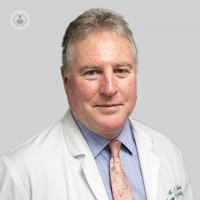Nasal deformity: what to expect during my first consultation
Written by:When you go to see a specialist about your nasal deformity, you would expect to be greeted and treated with respect as all patients would, and the doctor will ask you about the nature of your problem. It's worthwhile having in your mind an idea of the type of symptoms that have been troubling you, that are causing problems, and also the treatment that you've had from your GP. All of these things are important for the specialist to know but try and stick to the actual problem that you have without radiating to more peripheral health issues.

What happens during my first consultation for a nose job?
The doctor will examine your nose usually by looking at the external structure of your nose, your face, the quality of your skin and then we'll look up inside your nose. Sometimes it's necessary to look inside the nose with the fibre-optic telescope. It's not a painful thing. It's a bit ticklish. It feels a little weird. But after that, the doctor will have a much better idea of exactly what the nature of your problem is. The doctor will then explain to you what they think needs to be done and might take some photographs in the actual room itself, or they may ask a professional photographer to take photographs for you.
Unfortunately, taking pictures on your phone is not really sufficient enough because the photos are actually used on a professional basis for planning surgery. Scans might be required by X-ray and then you will come back and see the doctor again to discuss which treatment plan is going to be formulated.
How are nasal deformities treated?
Nasal deformities form a complex variety of issues and problems and no nose is the same. Every single one is unique and therefore has to be assessed completely separately with an individual treatment plan that will be formed for the particular issue.
Externally, these sorts of things are visible to you and your family but there may be internal problems that you may not be very aware of. Your consultant will explain this to you and perhaps show you a diagram of what needs to be done and explain the techniques that will be involved. Essentially, we are talking about rhinoplasty surgery to correct most of these deformities and there are different types of rhinoplasty operations. Typically, there is an internal operation and an external operation, which are used for different things.
The external operation is a little more extensive but it's more useful in the sense that it can deal with multiple problems all at the same time, whereas an internal rhinoplasty is a little bit more focused on one particular issue. The big difference between them as far as the patient is concerned is that there is a little incision just in the middle part of the nose (the columella). That gives the surgeon a great deal more exposure to deal with these multiple problems as I've mentioned.
What does recovery from rhinoplasty look like?
The surgery itself is carried out under general anaesthetic and the procedure typically takes around two and a half hours. Certainly, you'll need to take a week to 10 days off work and you may have plaster or some sort of a splint on your nose to protect it afterwards as the bones and cartilages may be mobile so they need to be protected.
There will be some swelling probably both externally and internally. With the external swelling, you might have some bruising or black eyes. Internally it may mean that your nose is blocked for a week or two after the surgery as you might expect if you had a cold or flu but gradually the swelling settles over a week or ten days and the bruising disappears. The plaster will be taken off a week after the sutures and gradually the whole thing will settle down.
Contact sports really should be avoided for probably about a month after the surgery because the nose is healing and could be bumped or damaged in so doing. So, it's one of these things. We have to be a little bit careful but usually, a little bit of care and diligence results in an excellent result. Cleaning the nose inside is important and your consultant will explain his or her particular preference for this and that will hopefully result in a good, much more patent breathing passage for you.


